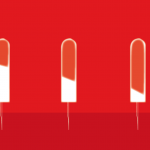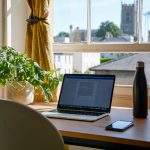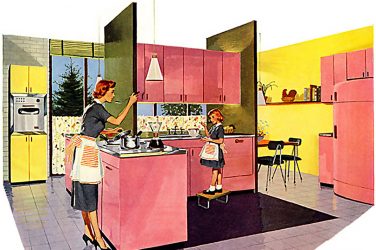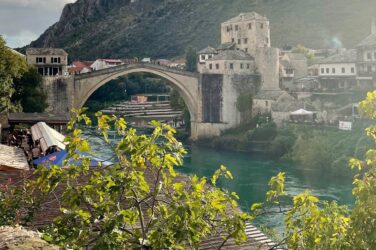Last issue we asked Young Europeans about their experiences with their period. The editors team at E&M wanted to dive a little deeper and open up conversations that have long been tabooed. We sat down with Ramona Brunner, who suffers from endometriosis, and asked her to share her experiences with us.
E&Me: Thank you very much for your time, Ramona. Let’s get right to it: What is Endometriosis? The first google hit says:
Endometriosis (en-doe-me-tree-O-sis) is an often painful disorder in which tissue similar to the tissue that normally lines the inside of your uterus — the endometrium — grows outside your uterus. Endometriosis most commonly involves your ovaries, fallopian tubes and the tissue lining your pelvis.
Is that correct?
Ramona: That is totally correct.
E&Me: When did you know that maybe the pain you’re feeling is not ‘normal’ – or that you should try and seek help?
Ramona: I think I felt it when I had my first period. Back then, I was 11 years old, a tiny 37kg gymnast. Right from the start, I had a 10-day long intense period with heavy bleeding, heavy pain and also diarrhea and PMS. My pediatrician largely ignored what I was telling him: he asked me if I have my period regularly (which I had) and if I have iron deficiency. Back then I didn’t even know what that was. I was a kid, just 11 or 12, feeling embarrassed and going through puberty. Until today I know exactly what I was wearing that day because I think I got somehow traumatized – that day my pain was labeled as “normal”.
When I was 15 I had my first boyfriend and started taking the pill as a contraceptive. I took it until I was 25. Meanwhile, my undetected endometriosis was growing on my bladder, peritoneum, ovary, rectum and basin wall. It caused heavy periods (every time I bled, all the endometriosis lesions outside my uterus also bled), cramps, back, tummy and kidney pain and a lot of bleeding. I was always wondering how that could be despite taking the pill.
I had more than ten different gynecologists back then as I moved a lot – and none of them acknowledged my pain or recognized a severe disease. Nobody believed me.
I had more than ten different gynecologists back then as I moved a lot – and none of them acknowledged my pain or recognized a severe disease. Nobody believed me, not even my sister (“you just want to be ill”) or my mum (“you got that from me – I also have difficulties”). They did not know better – I do not blame them. If you don’t have endo, you can’t imagine the pain endobabes go through – every period can be compared with being in labour or giving birth.
I swallowed more than 2.500 painkillers in almost 20 years of pain. In August 2020, my osteopath sent me to see his dad – a gynecologist who specializes in endometriosis. Ten days later I had my surgery, a so-called laparoscopy. It took more than one hour to remove all the inflammations in my endometrium. My doctor discovered a benign tumor on my left ovary which was completely covered with endo and overgrown with a part of my rectum. If it would have taken a few weeks longer they would have had to remove my ovary – in the end, I was lucky.
E&Me: Did you get help straight away? It’s still kind of under-researched and under-reported, no? Or is that just our perception?
Ramona: As you know now, I didn’t get help cause I was dis-empowered to listen to my body, which was obviously sick. When small girls are being told that things like period pains are normal, they believe it and they start downplaying it themselves – even in front of their gynecologist.
You feel ashamed that you can’t cope with the pain your period is giving you, because all the other girls can. You are not taken seriously. This is why it’s under-researched and under-reported: the perception is that girls and women “have to feel pain” during their periods. “It’s normal to lose a lot of blood.” “Some are more sensitive.” That’s bullshit, sorry. It is not normal if you can’t leave your house or even your bed. We need to tell this to every menstruating human being.
E&Me: Did you, on your road to healing and recovery, experience a gap in research surrounding female health?
Ramona: The gap is that there is almost no research at all. The pharma industry isn’t interested in endo because there is no cure, no pill, no vaccine – so you can’t make money with it. Prof. Dr. Sylvia Mechsner, the German “luminary” in endometriosis research, once said that if this would be a “male” disease there would be more research on it or even a cure. Her perception – and I am totally sharing it – is that boys and their pain are taken more seriously than “girls’ issues”.
You feel ashamed that you can’t cope with the pain your period is giving you, because all the other girls can.
E&Me: How does it now affect your daily live?
Ramona: For me, endo is like a dark cloud that hovers invisibly above me but can turn into a heavy downpour at any time. Or a little monster, a chameleon in my stomach that sleeps contentedly and then, for whatever reason, wakes up completely freaked out and makes my life hell. I still have pain surges about once a month and they sometimes strike me down for several days. After my surgery, a part of my peritoneum didn’t grow over – this is why I am still suffering sometimes.
It takes time – a long time. The total recovery can take almost two years. It’s hard work and it somehow turns into a “hobby” as you spend so much time with your own healing. Here are some of my recommendations:
TCM (traditional Chinese medicine) with herbs and acupuncture is great. I swear by osteopathy and movement therapy as well as womb healing. A change in diet now also helps me with digestion and to reduce stomach pains (sugar / gluten-free and vegan, no alcohol). I also do psychotherapy because talking helps a lot. Through the years of pain, but also its suppression, I not only put a lot of strain on my body but also my soul. This caused damage: I do not feel my body, it is difficult for me to pay attention to myself and to listen to my feelings. There is also a mixture of self-hatred and the feeling of “not being enough” as well as a completely shifted self-image.
It is difficult for me to feel my own (stress) limits and to set them for myself or other people. I’ve been functioning all these years and not giving my body a voice – I want to change that now. In addition, it is already difficult to cope with the fact that, in addition to the pain, the disease may also lead to me being unable to have children.
It is difficult for me to feel my own (stress) limits and to set them for myself or other people. I’ve been functioning all these years and not giving my body a voice – I want to change that now.
I haven’t had any negative experiences so far with alternative therapies – I always try to get good information beforehand. I also have a couple of great gadgets: in addition to the obligatory hot water bottle, for example, a warming Tens device that you can stick on your stomach, a Shakti mat for my pain meditation (inuhealth), my calming or pain relieving CBD oil and my beloved therapy blanket for sleeping that weighs 6kg.
E&Me: What do you need to be able to “live” with this? That is, are there specific things needed for people that suffer from Endometriosis? E.g. at the workplace, from your friends/ family, while traveling….?
Ramona: You need money, cause alternative therapies are not really covered by your health insurance (unless it’s private). You need understanding within your family, friends, bosses and colleagues. You need to educate everyone around you – you need a voice and you need people who really listen. You need to speak up – to everybody even if they don’t want to hear it. We need to create understanding.
I am hoping for: More research funding, more support from health insurances and better trained doctors. Endo is of no interest to the pharmaceutical industry because there is no drug against it. It is a cheek that the health insurance pays little or nothing, although endogirls sometimes use alternative therapies to alleviate the pain. Even the spiral is usually not paid for.
And it is negligence that doctors have no idea how to recognize endo. Or not even refer you to a specialist. Many just want to sell you a hormone supplement.
E&Me: Thank you so, so much for taking the time, for sharing and for being an all-around amazing woman.

Cover photo by @cloudsandillustrations










